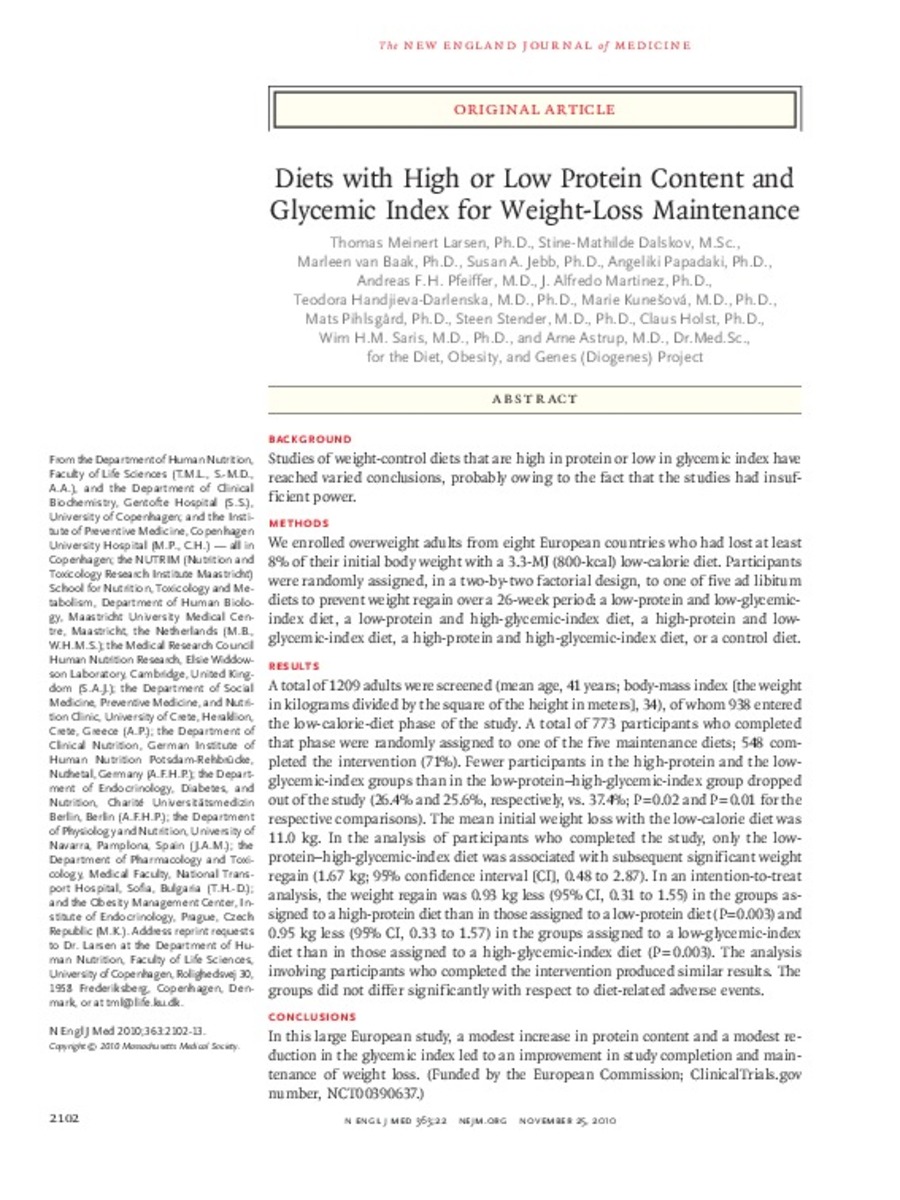Full metadata record
| DC Field | Value | Language |
|---|---|---|
| dc.creator | Larsen, T.M. (Thomas M.) | - |
| dc.creator | Dalskov, S.M. (S.M.) | - |
| dc.creator | Van-Baak, M.A. (M.A.) | - |
| dc.creator | Jebb, S.A. (Susan A.) | - |
| dc.creator | Papadaki, A. (Angeliki) | - |
| dc.creator | Pfeiffer, A.F. (A.F.) | - |
| dc.creator | Martinez, J.A. (José Alfredo) | - |
| dc.creator | Handjieva-Darlenska, T. (Teodora) | - |
| dc.creator | Kunesova, M. (Marie) | - |
| dc.creator | Pihlsgård, M. (M.) | - |
| dc.creator | Stender, S. (Steen) | - |
| dc.creator | Holst, C. (C.) | - |
| dc.creator | Saris, W.H.M. (Wim H. M.) | - |
| dc.creator | Astrup, A. (Arne) | - |
| dc.date.accessioned | 2013-04-07T11:29:34Z | - |
| dc.date.available | 2013-04-07T11:29:34Z | - |
| dc.date.issued | 2010 | - |
| dc.identifier.citation | Larsen TM, Dalskov SM, van Baak M, Jebb SA, Papadaki A, Pfeiffer AF, et al. Diets with high or low protein content and glycemic index for weight-loss maintenance. N Engl J Med 2010 Nov 25;363(22):2102-2113 | es_ES |
| dc.identifier.issn | 0028-4793 | - |
| dc.identifier.uri | https://hdl.handle.net/10171/28217 | - |
| dc.description.abstract | BACKGROUND: Studies of weight-control diets that are high in protein or low in glycemic index have reached varied conclusions, probably owing to the fact that the studies had insufficient power. METHODS: We enrolled overweight adults from eight European countries who had lost at least 8% of their initial body weight with a 3.3-MJ (800-kcal) low-calorie diet. Participants were randomly assigned, in a two-by-two factorial design, to one of five ad libitum diets to prevent weight regain over a 26-week period: a low-protein and low-glycemic-index diet, a low-protein and high-glycemic-index diet, a high-protein and low-glycemic-index diet, a high-protein and high-glycemic-index diet, or a control diet. RESULTS: A total of 1209 adults were screened (mean age, 41 years; body-mass index [the weight in kilograms divided by the square of the height in meters], 34), of whom 938 entered the low-calorie-diet phase of the study. A total of 773 participants who completed that phase were randomly assigned to one of the five maintenance diets; 548 completed the intervention (71%). Fewer participants in the high-protein and the low-glycemic-index groups than in the low-protein-high-glycemic-index group dropped out of the study (26.4% and 25.6%, respectively, vs. 37.4%; P=0.02 and P=0.01 for the respective comparisons). The mean initial weight loss with the low-calorie diet was 11.0 kg. In the analysis of participants who completed the study, only the low-protein-high-glycemic-index diet was associated with subsequent significant weight regain (1.67 kg; 95% confidence interval [CI], 0.48 to 2.87). In an intention-to-treat analysis, the weight regain was 0.93 kg less (95% CI, 0.31 to 1.55) in the groups assigned to a high-protein diet than in those assigned to a low-protein diet (P=0.003) and 0.95 kg less (95% CI, 0.33 to 1.57) in the groups assigned to a low-glycemic-index diet than in those assigned to a high-glycemic-index diet (P=0.003). The analysis involving participants who completed the intervention produced similar results. The groups did not differ significantly with respect to diet-related adverse events. CONCLUSIONS: In this large European study, a modest increase in protein content and a modest reduction in the glycemic index led to an improvement in study completion and maintenance of weight loss. | es_ES |
| dc.language.iso | eng | es_ES |
| dc.publisher | Massachusetts Medical Society | es_ES |
| dc.rights | info:eu-repo/semantics/openAccess | es_ES |
| dc.subject | Dietary proteins | es_ES |
| dc.subject | Glycemic index | es_ES |
| dc.subject | Overweight | es_ES |
| dc.subject | Diet reducing | es_ES |
| dc.subject | DiOGenes | es_ES |
| dc.title | Diets with high or low protein content and glycemic index for weight-loss maintenance | es_ES |
| dc.type | info:eu-repo/semantics/article | es_ES |
| dc.type.driver | info:eu-repo/semantics/article | es_ES |
| dc.identifier.doi | http://dx.doi.org/10.1056/NEJMoa1007137 | es_ES |
Files in This Item:
Statistics and impact
Items in Dadun are protected by copyright, with all rights reserved, unless otherwise indicated.






